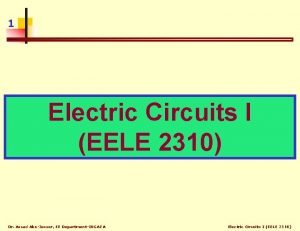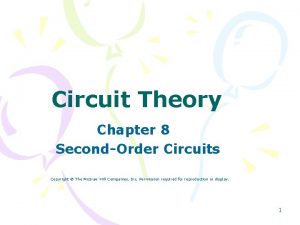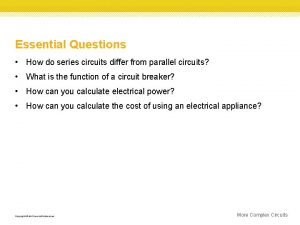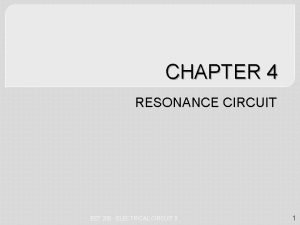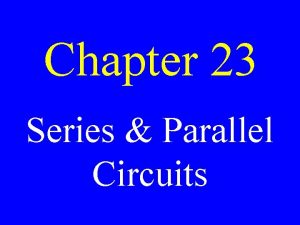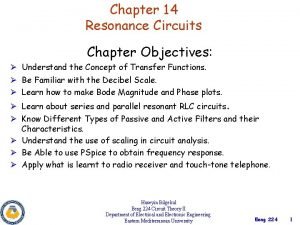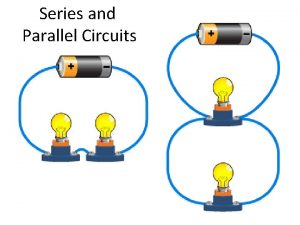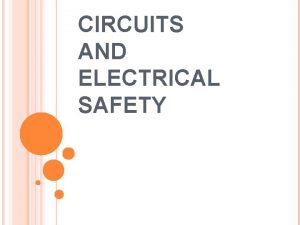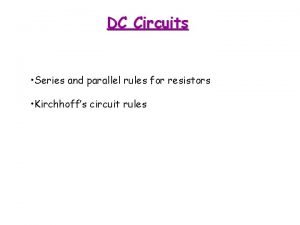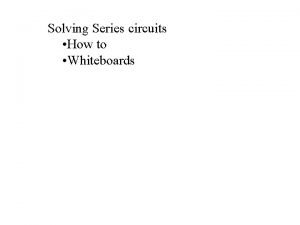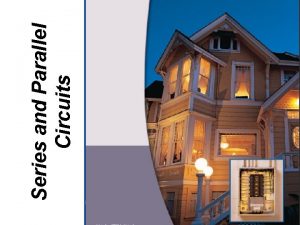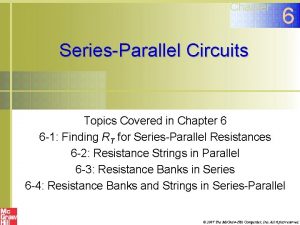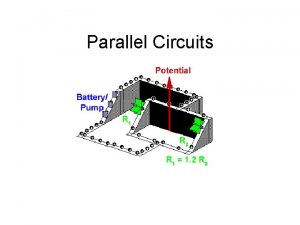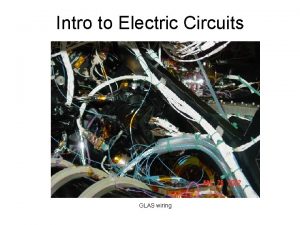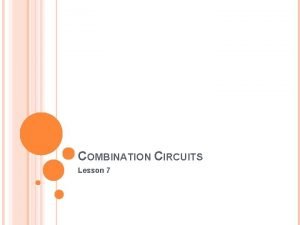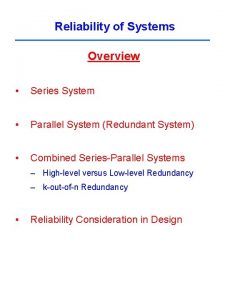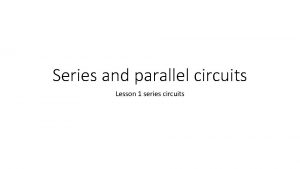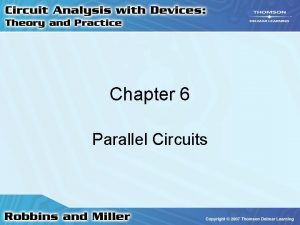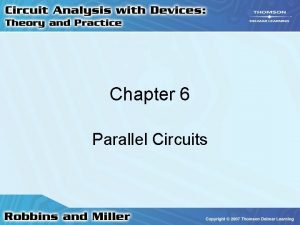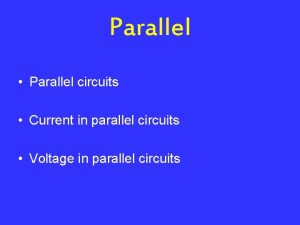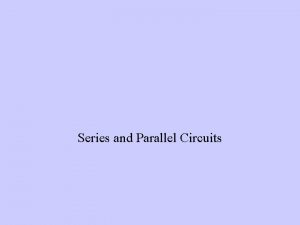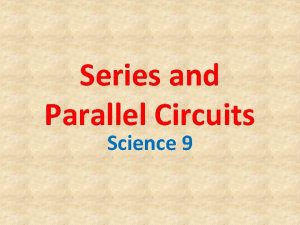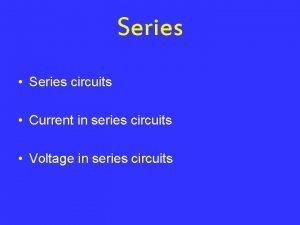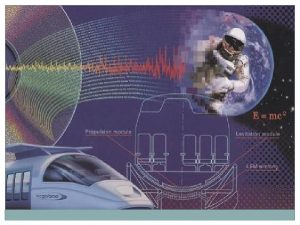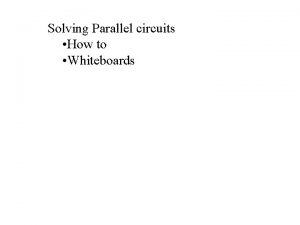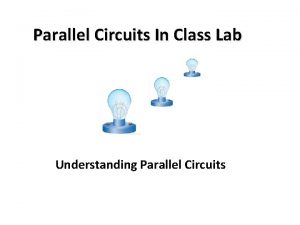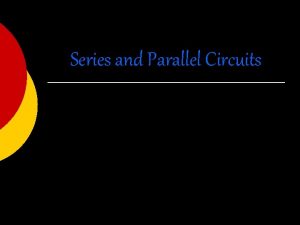Series and Parallel Circuits Lesson 6 The two


























- Slides: 26

Series and Parallel Circuits Lesson 6

�The two simplest ways to connect conductors and load are series and parallel circuits. 1. Series circuit - A circuit in which loads are connected one after another in a single path. 2. Parallel circuit – A circuit in which loads are connected side by side.

Gustav Robert Kirchhoff �Each arrangement affects the way in which potential difference and current act in the various parts of the circuit. Gustav Robert Kirchhoff studied the way each of the circuit parameters behaved in series and parallel circuits. His research led to two laws.

Kirchhoff’s current law � the total amount of current into a junction point of a circuit equals the total current that flows out of that same junction.

�In the diagram to blow, three branches are coming together at one junction point and two branches leave. I 1 + I 2 + I 3 = I 4 + I 5

Kirchhoff’s Voltage Law �The total of all electric potential difference in any complete circuit loop is equal to any potential increases in the circuit loop.

potential increase, VT is equivalent to the sum of all the potential losses so that V 1 �VT = V 1 + V 2 + V 3 V 2 VT �The

�Kirchhoff’s laws are particular applications of the laws of conservation of electric charge and the conservation of energy. �In any circuit, there is no net gain or loss of electric charge or energy.

Example 1: Kirchhoff’s law in a series circuit �A simple series circuit is seen below. Use Kirchhoff’s current and voltage laws to find the values of the missing voltage (V 2) and current (I 2) 30 V 10. 0 A R 1 R 2 30 V I 3 V 2 100 v 10. 0 A

Voltage �according to Kirchhoff’s law, this series circuit has one voltage increase of 100 V. This voltage must be distributed so that the sum of all voltage drops for each individual resistor must equal this value.

�VT = V 1 + V 2 + V 3 �So V 2 = VT – V 1 – V 3 �V 2 = 100 V – 30 V � = 40 V 30 V 10. 0 A R 1 R 2 30 V I 3 V 2 100 v 10. 0 A

Current �According to Kirchhoff’s current law, this series circuit has no real junction point, so it has only one path to follow. Therefore,

�IT = I 1 = I 2 = I 3 = �IT = 10 A 30 V 10. 0 A R 1 R 2 30 V I 3 V 2 100 v 10. 0 A

Example 2: Kirchhoff’s laws in a parallel circuit �A simple parallel circuit shown below shows how Kirchhoff’s current and voltage laws can be used to find the missing voltage (V 2) and current (I 3). 30 V R 3 30 V 3. 0 A R 2 V 2 30 V 9. 0 A R 1 3. 0 A I 3

Voltage R 3 30 V 3. 0 A R 2 V 2 30 V voltage increase is 30 V, thus there must be a decrease for each of the three different parallel resistor paths. Therefore, VT = V 1 = V 2 = V 3 �The voltage drop across all three parallel resistors is 30 V, no matter what their resistances. 9. 0 A 30 V �The R 1 3. 0 A I 3

Current �There are 4 junction points in this diagram. One at the top and bottom of each branch, to resistors 1 and 2. The sum of the current entering the junctions must equal the sum exiting. 9. 0 A 30 V 30 V R 3 V 2 R 1 3. 0 A I 3


Resistance in series �In a series circuit, all current must first pass through resistor 1, then 2, and so on. The voltage drops across each resistor. The sum of the voltage drops gives the overall voltage drop in the 30 V circuit. 10. 0 A R 1 30 V R 3 R 2 V 2 10 0 v 10. 0 A

�From Kirchhoff’s law, VT = V 1 + V 2 + V 3 �From Ohm’s law, ITRT = I 1 R 1 + I 2 R 2 + I 3 R 3 �But from Kirchhoff’s law, IT = I 1 = I 2 = I 3 �The currents factor out; IRT = IR 1 + IR 2 + IR 3 �Therefore, RT = R 1 + R 2 + R 3 �If all the resistors are the same, use

Example 3: Resistors in series �What is the series equivalent resistance of 10 Ω, 20 Ω, and 30 Ω resistors connected in series? �RT = R 1 + R 2 + R 3 �Therefore, RT = 10 Ω + 20 Ω + 30 Ω 30 V �= 60 Ω. 10. 0 A R 1 30 V R 3 R 2 V 2 10 0 v 10. 0 A

Resistance in parallel �In a parallel circuit, the total current must split and distribute its self among all of the available circuit paths. �From Kirchhoff’s law, IT = I 1 + I 2 + I 3 �From Ohm’s law �But from Kirchhoff’s law VT = V 1 = V 2 = V 3 �The voltages factor out �Therefore,

�If all the resistors are the same, use the formula 30 V R 3 30 V 3. 0 A R 2 V 2 30 V 9. 0 A R 1 3. 0 A I 3

Example: Resistors in parallel �What is the parallel equivalent resistance for a 25 Ω, 40 Ω, and 10 Ω resistors wired in parallel?

�Therefore,

�This can calculated easily on the calculator by using the fraction button. ◦ a b/c button �= 33/200 �RT = 200 / 33 = 6. 1

Questions � Calculate the total resistance for the following: ◦ Three resistors, each 20 Ω, connected in series ◦ Three resistors, each 20 Ω, connected in parallel � Calculate the total current in a parallel circuit with current of I 1 = 2. 1 A in resistor 1, I 2 = 3. 1 in resistor 2 and I 3 = 4. 2 in resistor 3. � Calculate the total potential difference in a series circuit with a potential difference of V 1 = 12 V in resistor 1, V 2 = 14 V in resistor 2 and V 3 = 16 V in resistor 3. � Calculate the equivalent resistance of a circuit with the flowing resistors in parallel: 5 Ω, 10 Ω, and 30 Ω. � A 1. 0 Ω resistor is hooked up to a 1. 0 x 106 Ω resistor in a) series , b) parallel. For each situation, calculate the total resistance and explain the dominance of one resistor in the total value.
 Advantages of parallel circuits over series circuit
Advantages of parallel circuits over series circuit Lesson 8: comparing series and parallel rlc circuits
Lesson 8: comparing series and parallel rlc circuits Lesson 8: comparing series and parallel rlc circuits
Lesson 8: comparing series and parallel rlc circuits Parallel circuit
Parallel circuit Difference between series and parallel circuit
Difference between series and parallel circuit Series circuit questions
Series circuit questions Parallel circuit characteristics
Parallel circuit characteristics Chapter 23 series and parallel circuits answers
Chapter 23 series and parallel circuits answers Parallel resonance
Parallel resonance Facts about parallel circuits
Facts about parallel circuits Bill nye current electricity
Bill nye current electricity Concept map
Concept map Venn diagram series and parallel circuits
Venn diagram series and parallel circuits Series and parallel circuits rules
Series and parallel circuits rules Series vs parallel
Series vs parallel Lesson outline lesson 3 describing circuits answers
Lesson outline lesson 3 describing circuits answers It is an outer terminus of fingerprint pattern:
It is an outer terminus of fingerprint pattern: Solving series circuits
Solving series circuits Applications of series circuits
Applications of series circuits Circuits
Circuits Solving parallel circuits
Solving parallel circuits Types of parallel circuits
Types of parallel circuits Contiusly
Contiusly Series aiding and series opposing
Series aiding and series opposing Describing circuits lesson 3 answer key
Describing circuits lesson 3 answer key Equivalent resistance formula
Equivalent resistance formula Reliability in series and parallel
Reliability in series and parallel

